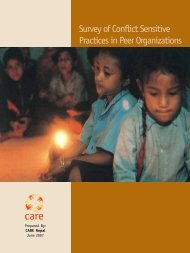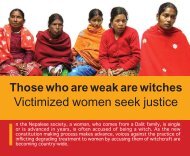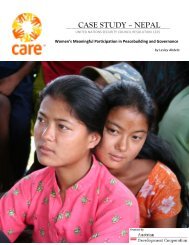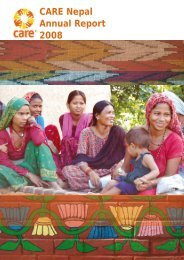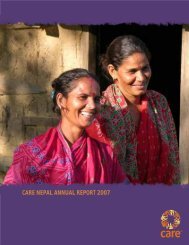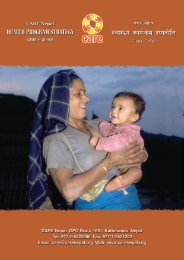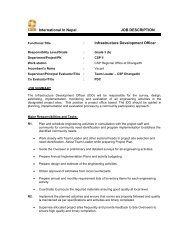Untitled - Care Nepal
Untitled - Care Nepal
Untitled - Care Nepal
Create successful ePaper yourself
Turn your PDF publications into a flip-book with our unique Google optimized e-Paper software.
Lack of decision making power in<br />
reproductive health is a crucial issue in<br />
women’s disempowerment. International<br />
research shows for example, that women<br />
have poor psychosocial status due to<br />
reproductive health related factors such as<br />
sexual abuse to the women by non spouse,<br />
verbal abuse and sexual exploitation from<br />
their spouses (V Patel, HA Weiss, BR<br />
Kirkwood, S Pednekar, P - International<br />
journal of epidemiology, 2006–IEA).<br />
Pregnant women from low income<br />
countries have had high prevalence of<br />
physical and mental violence compared to<br />
developed countries. (Eliette Valladares a ,<br />
Rodolfo Peña a , Lars Åke Persson b , Ulf<br />
Högberg c , 2005). Women in South Africa<br />
have had higher level of distress due to<br />
childlessness compared with women who<br />
had children (S.J. Dyer 1, 4 , N. Abrahams 2 ,<br />
N.E. Mokoena 1 , C.J. Lombard 3 and Z.M.<br />
van der Spuy).<br />
Women use different coping strategies to<br />
overcome the psychosocial problems<br />
caused by social and gender based violence.<br />
Majority of women fought back first and<br />
some of them left home to escape from<br />
severe physical abuse however many<br />
returned back after some hours. The<br />
majority of women share their problems<br />
with their parents and a few of them go to<br />
the authorities for protection and rights. (S.J.<br />
Dyer 1, 4 , N. Abrahams 2 , N.E. Mokoena 1 , C.J.<br />
Lombard 3 and Z.M. van der Spuy).<br />
ARMED CONFLICT<br />
CONTEXT IN NEPAL<br />
After the 40 point demand was ignored by<br />
His Majesty’s Government, on February 13,<br />
1996, the CPN(M) attacked police posts<br />
and a state-owned agricultural development<br />
bank thus starting the “People’s War”.<br />
Initially, the People’s War led by Chairman<br />
Prachanda, Supreme Commander of the<br />
CPN (M), was limited to minor attacks on<br />
police posts in the Midwestern<br />
Development Region. Then a soft-drink<br />
bottling factory owned by a multi-national<br />
company was attacked and a portion of the<br />
building torched in Kathmandu. A liquor<br />
factory was blown up in Gorkha district and<br />
the office of the Small Farmer’s<br />
Development Program of the state-owned<br />
Agricultural Development Bank attacked.<br />
A landlord’s house was raided at night; cash<br />
and other properties worth 1.3 million<br />
rupees seized, and loan documents worth<br />
several million rupees reportedly destroyed.<br />
However, no attacks were made on the<br />
Royal <strong>Nepal</strong> Army, and King Birendra did<br />
not use the RNA against the Maoists<br />
(Mehta, 2005; Ogura, 2004).<br />
The violence continued to be isolated until<br />
2001, when several factors converged to<br />
change drastically the situation. In June of<br />
2001, the Royal Massacre occurred. The<br />
public story was that the crown prince had<br />
killed his father, King Birendra, and the<br />
majority of the royal family before killing<br />
himself. The conspiracy theory in the<br />
bazaars and tea shops was that Gyanendra,<br />
King Birendra’s younger brother, had<br />
orchestrated the massacre with the<br />
Psychosocial Issues of<br />
Women affected by conflict<br />
7



